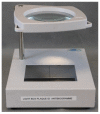Validation of Three MicroScan® Antimicrobial Susceptibility Testing Plates Designed for Low-Resource Settings
- PMID: 36140507
- PMCID: PMC9497938
- DOI: 10.3390/diagnostics12092106
Validation of Three MicroScan® Antimicrobial Susceptibility Testing Plates Designed for Low-Resource Settings
Abstract
Easy and robust antimicrobial susceptibility testing (AST) methods are essential in clinical bacteriology laboratories (CBL) in low-resource settings (LRS). We evaluated the Beckman Coulter MicroScan lyophilized broth microdilution panel designed to support Médecins Sans Frontières (MSF) CBL activity in difficult settings, in particular with the Mini-Lab. We evaluated the custom-designed MSF MicroScan Gram-pos microplate (MICPOS1) for Staphylococcus and Enterococcus species, MSF MicroScan Gram-neg microplate (MICNEG1) for Gram-negative bacilli, and MSF MicroScan Fastidious microplate (MICFAST1) for Streptococci and Haemophilus species using 387 isolates from routine CBLs from LRS against the reference methods. Results showed that, for all selected antibiotics on the three panels, the proportion of the category agreement was above 90% and the proportion of major and very major errors was below 3%, as per ISO standards. The use of the Prompt inoculation system was found to increase the MIC and the major error rate for some antibiotics when testing Staphylococci. The readability of the manufacturer's user manual was considered challenging for low-skilled staff. The inoculations and readings of the panels were estimated as easy to use. In conclusion, the three MSF MicroScan MIC panels performed well against clinical isolates from LRS and provided a convenient, robust, and standardized AST method for use in CBL in LRS.
Keywords: MicroScan; antibiotic susceptibility testing; clinical bacteriology; low-resource settings.
Conflict of interest statement
The authors declare no conflict of interest. The manufacturer of the panels had no role in the design of the study, in the collection, analyses, or interpretation of data, in the writing of the manuscript, or in the decision to publish the results.
Figures



References
-
- Nadimpalli M., Delarocque-Astagneau E., Love D.C., Price L.B., Huynh B.-T., Collard J.-M., Lay K.S., Borand L., Ndir A., Walsh T., et al. Combating Global Antibiotic Resistance: Emerging One Health Concerns in Lower-and Middle-Income Countries. Clin. Infect. Dis. 2018;66:963–969. doi: 10.1093/cid/cix879. - DOI - PubMed
-
- Iskandar K., Molinier L., Hallit S., Sartelli M., Catena F., Coccolini F., Hardcastle T.C., Roques C., Salameh P. Drivers of antibiotic resistance transmission in low-and middle-income countries from a ‘one health’ perspective—A review. Antibiotics. 2020;9:372. doi: 10.3390/antibiotics9070372. - DOI - PMC - PubMed
-
- O’Neill J. Tackling Drug-Resistant Infections Globally: Final Report and Recommendations. The Review on Antimicrobial Resistance; London, UK: May, 2016.
Grants and funding
LinkOut - more resources
Full Text Sources
Molecular Biology Databases
Miscellaneous

